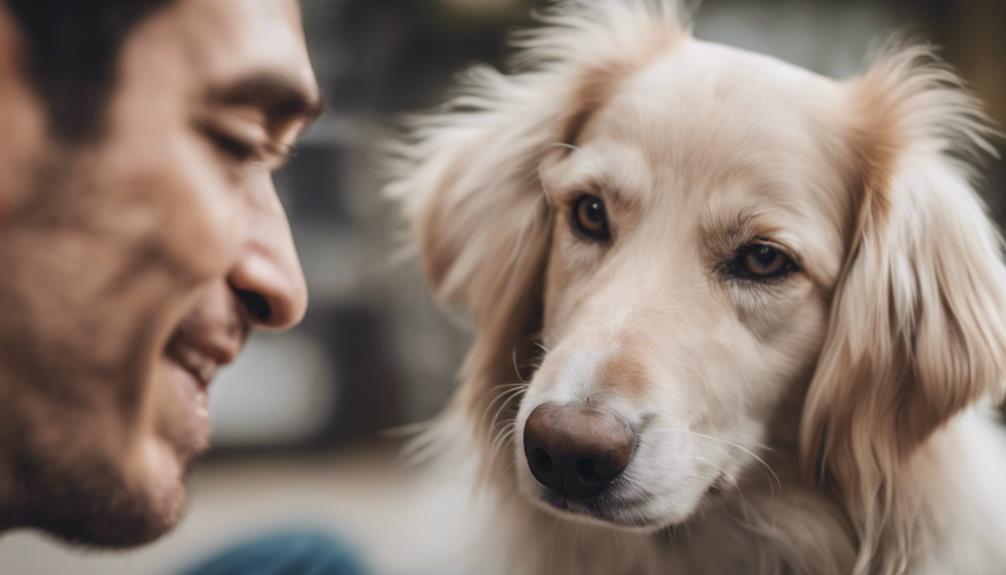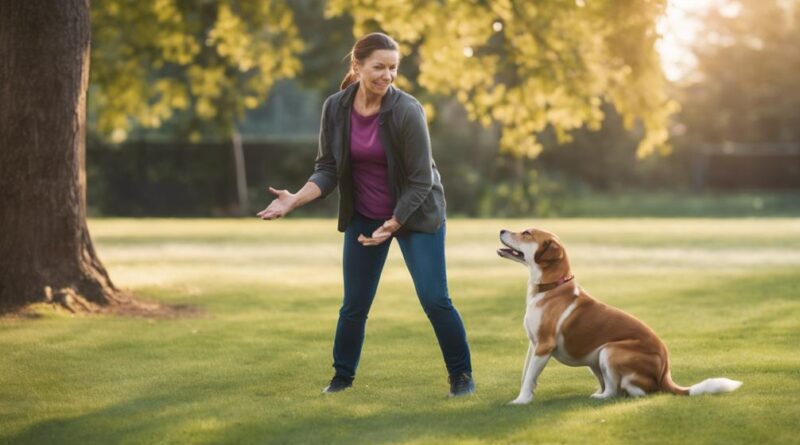Improving Dog Training Through Understanding Canine Psychology
Ever wonder why your dog seems to have a Ph.D. in getting treats but struggles with basic commands? Understanding canine psychology can shed light on these mysteries.
By deciphering the intricacies of their behavior, you can unlock the key to a harmonious relationship with your furry companion.
From decoding their communication signals to utilizing effective training techniques, a deeper comprehension of your dog's psyche can revolutionize the way you interact with them.
So, are you ready to uncover the secrets behind your pup's behaviors and enhance your training methods?
Canine Communication Signals
Understanding how dogs communicate through various signals is crucial for effective dog training. Dogs primarily communicate through body language and vocal cues. Paying attention to your dog's body language can provide valuable insights into their emotions and intentions. For example, a relaxed and wagging tail usually indicates a happy and friendly disposition, while a tucked tail might signal fear or anxiety. Similarly, a dog's posture, facial expressions, and eye contact can convey important messages about their state of mind.
In addition to body language, dogs also use vocal cues to communicate. Barking, growling, whimpering, and whining are all forms of vocal communication that can indicate different emotions or needs. For instance, a sharp and continuous bark could signify alertness or a perceived threat, while a low growl might indicate aggression or discomfort. By understanding and interpreting these vocal cues along with body language, you can better communicate with your dog and establish a strong foundation for effective training.
Pack Mentality in Training
How does the concept of pack mentality influence dog training effectiveness? Understanding the social hierarchy and pack dynamics within a group of dogs is crucial for successful training. Dogs are naturally inclined to form social structures resembling a pack, where each member has a specific rank or role. When training your dog, it's essential to establish yourself as the leader of the pack. By doing so, you can gain your dog's respect and obedience more effectively.
In a pack, there's a clear order of dominance, with some dogs being more dominant than others. By recognizing and respecting this hierarchy, you can better understand your dog's behavior and motivations. Incorporating pack mentality into training helps you communicate with your dog in a way that aligns with their natural instincts.
During training sessions, observe how your dog responds to different commands and corrections. Adjust your approach based on their reactions, keeping in mind the pack dynamics that influence their behavior. By acknowledging and working with your dog's pack mentality, you can enhance the effectiveness of your training efforts.
Instinctual Behavior Patterns
Observing your dog's instinctual behavior patterns can provide valuable insights into their natural tendencies and reactions during training sessions. Understanding these innate behaviors, such as prey drive and territorial instincts, can help you tailor your training methods effectively.
- Prey Drive
- Dogs with a high prey drive may be more responsive to training involving chasing or fetching activities.
- Territorial Instincts
- Recognizing territorial behaviors can help in managing your dog's reactions to strangers or other animals in their space.
- Scent Marking
- Dogs have a natural urge to mark their territory, which can impact their behavior during training sessions.
- Social Hierarchy
- Instinctual behaviors related to establishing social hierarchies within the pack can influence how your dog responds to your leadership during training sessions.
Dominance Vs. Leadership
When training your dog, distinguishing between dominance and leadership is crucial for establishing a healthy and respectful relationship.
Dominance refers to a relationship where one individual asserts control over another through force or coercion. On the other hand, leadership involves guiding and directing behavior through influence and trust.
In the context of dog training, displaying dominance can lead to fear, submission, and potential behavioral issues. Instead, focusing on leadership promotes obedience, respect, and a strong bond between you and your furry companion.
Canine Emotions and Responses
Understanding the emotions and responses of canines is essential for effective dog training. Dogs, like humans, have emotional intelligence and display various behavioral cues that can help us comprehend their feelings.
Here are some key points to consider:
- Body Language: Canines often communicate through body language, such as wagging tails, raised hackles, or relaxed postures.
- Facial Expressions: Pay attention to their facial expressions, including relaxed eyes or tense mouth, to gauge their emotional state.
- Vocalizations: Dogs use barks, whines, and growls to convey their emotions, indicating fear, excitement, or aggression.
- Response to Stimuli: Observing how your dog reacts to different stimuli can provide insights into their likes, dislikes, and comfort levels.
Learning Styles of Dogs
To effectively train your dog, it's crucial to recognize and understand the various learning styles that dogs exhibit. Dogs have different behavioral responses when it comes to learning new commands or behaviors. Some dogs may respond well to positive reinforcement, such as treats or praise, while others might require a more structured and disciplined approach. Understanding your dog's learning style can help you tailor your training methods to suit their needs.
When it comes to training methods, it's essential to be patient and consistent. Dogs thrive on routine and repetition, so practicing commands regularly is key to reinforcing their learning. Incorporating rewards and praise for good behavior can help motivate your dog and strengthen the bond between you.
Keep in mind that each dog is unique, and what works for one may not work for another. Observing your dog's behavioral responses and adjusting your training methods accordingly will help you achieve better results in your training sessions. By being attentive to your dog's learning style, you can create a positive and effective training environment for them.
Building Trust and Bonding

Developing a strong bond with your dog is essential for successful training and a harmonious relationship. To build trust and strengthen your bond with your furry friend, consider the following bonding techniques:
- Quality Time: Spend dedicated one-on-one time with your dog, engaging in activities they enjoy, such as playing, walking, or cuddling.
- Positive Reinforcement: Use treats, praise, and affection to reward good behavior, creating a positive association with training sessions.
- Consistency: Establish clear rules and boundaries, and be consistent in your interactions to help your dog feel secure and understand what's expected.
- Communication: Learn to read your dog's body language and cues to better understand their needs and feelings, strengthening the bond between you.
Positive Reinforcement Techniques
Building a strong relationship with your dog through positive reinforcement is key to effective training and fostering a happy companionship. Clicker training and treat rewards are powerful tools in positive reinforcement techniques. Clicker training involves using a clicker device paired with treats to mark desired behaviors. The click serves as a marker cue, indicating to your dog that they've performed the correct action, followed by a treat reward to reinforce that behavior. This technique helps in shaping behavior by breaking it down into smaller achievable steps.
When implementing positive reinforcement, consistency is crucial. Make sure to click and treat immediately after the desired behavior occurs, so your dog associates the reward with the correct action. Through shaping behavior with marker cues, you can guide your dog to understand complex commands or tricks. Positive reinforcement techniques not only enhance your training sessions but also strengthen the bond between you and your furry friend.
Frequently Asked Questions
How Can a Dog's Breed Affect Their Learning Style and Behavior in Training?
When it comes to how a dog's breed influences their learning style and behavior in training, breed differences play a significant role. Different breeds have unique characteristics that can affect how they respond to training methods.
Understanding these breed-specific traits can help tailor your approach to match their learning styles. By recognizing these distinctions, you can effectively utilize behavior modification techniques that cater to the individual needs of each breed during training sessions.
Are There Any Specific Body Language Cues That Indicate a Dog Is Feeling Anxious or Stressed During Training?
When your dog is feeling anxious or stressed during training, look for signs like lowered ears, tucked tail, or avoiding eye contact. Understanding stress signals is crucial.
Make training adjustments by giving your pup breaks and using positive reinforcement techniques. Recognizing anxiety allows you to create a supportive environment.
Can a Dog's Past Experiences or Traumas Impact Their Ability to Learn and Respond to Training Techniques?
Yes, a dog's past experiences or traumas can greatly impact their ability to learn and respond to training techniques. Emotional triggers from previous negative encounters may hinder training progress.
Trust building is crucial in these cases, and using rehabilitation techniques can help your dog overcome past traumas and develop a positive response to training.
Patience and understanding are key when working with a dog that has experienced difficulties in the past.
How Can a Dog Owner Effectively Establish Themselves as a Leader Without Resorting to Dominance-Based Training Methods?
To establish yourself as a leader without resorting to dominance-based methods, focus on positive reinforcement. Show leadership by being consistent, setting clear boundaries, and rewarding good behavior.
Communication is key – use cues, body language, and voice tone to convey your expectations. Build trust through bonding activities and spending quality time together.
What Role Does Genetics Play in a Dog's Behavior and Ability to Learn New Commands or Tricks?
When it comes to your dog's behavior and learning abilities, genetics, also known as nature, play a significant role. Each dog is unique, with inherited traits that affect their intelligence and how they respond to training.
This nature vs. nurture debate is ongoing, but understanding your dog's genetic predispositions can help tailor your training approach to be more effective. Embrace your pup's genetic makeup to enhance their learning potential and bond with them more deeply.
Conclusion
By understanding canine psychology, you can improve your dog training skills and strengthen your bond with your furry companion.
Pay attention to their communication signals, respect their pack mentality, and use positive reinforcement techniques to encourage good behavior.
Remember, dogs respond best to patience, consistency, and love.
Keep learning and adapting your training methods to meet your dog's unique needs, and you'll both reap the rewards of a happy and well-behaved pup.
